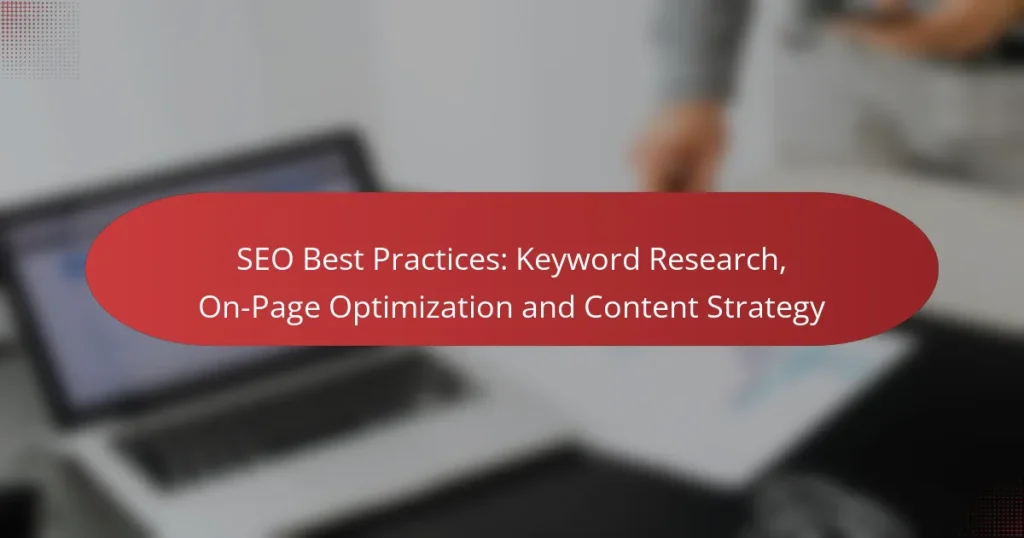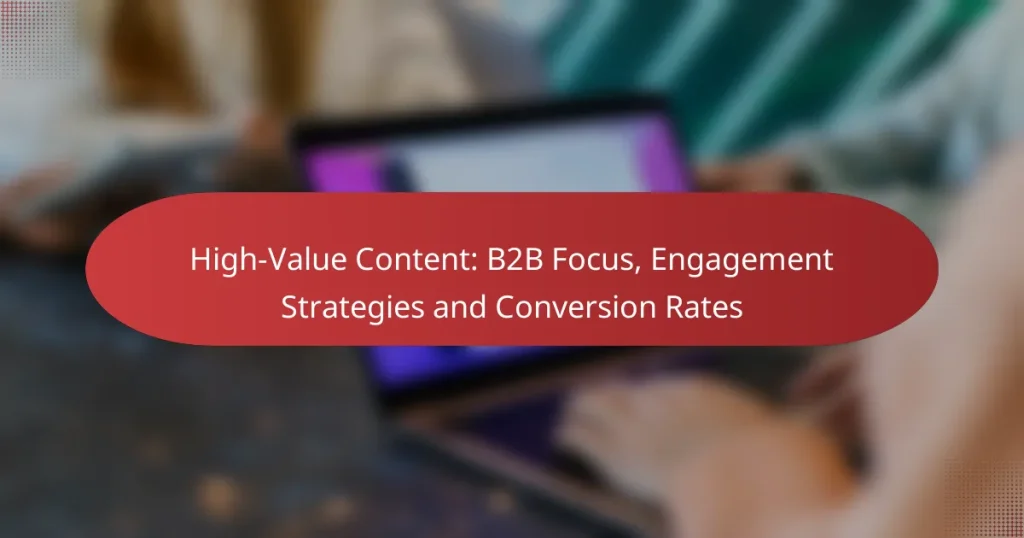Content optimization for leads is essential in attracting and converting potential customers through relevant and engaging material. By focusing on targeted keywords, clear calls-to-action, and a seamless user experience, businesses can effectively drive lead generation. Utilizing data-driven insights and tools like SEMrush and Google Analytics further enhances visibility and engagement, ensuring that content resonates with the intended audience.
Video Marketing: Engagement, Brand Awareness and Client Attraction
User-Generated Content: Trust Building, Community Engagement and Authenticity
A/B Testing: Content Variations, User Engagement and Performance Insights
Compelling Calls-to-Action: Design, Placement and Persuasive Language
Content Performance Metrics: Engagement Rates, Conversion Tracking and ROI
High-Value Content: B2B Focus, Engagement Strategies and Conversion Rates
How to Optimize Content for Lead Generation?
To optimize content for lead generation, focus on creating relevant, engaging material that attracts and converts potential customers. This involves using targeted keywords, implementing clear calls-to-action, enhancing user experience, utilizing data-driven insights, and leveraging social proof.
Use targeted keywords
Targeted keywords are essential for ensuring your content ranks well in search engines and reaches your intended audience. Conduct keyword research to identify terms and phrases that potential leads are searching for, and incorporate these naturally into your content.
Aim for a mix of short-tail and long-tail keywords to capture a broader audience. For instance, instead of just using “marketing,” consider phrases like “digital marketing strategies for small businesses.” This helps attract more specific leads who are further along in the buying process.
Implement clear calls-to-action
Clear calls-to-action (CTAs) guide users on what to do next, making it easier for them to engage with your content. Use strong, action-oriented language that encourages users to take specific steps, such as “Download our free guide” or “Sign up for our newsletter.”
Position CTAs strategically within your content, such as at the end of articles or in pop-ups. Ensure they stand out visually, using contrasting colors or buttons to draw attention. Test different CTAs to see which ones yield the best conversion rates.
Enhance user experience
A positive user experience is crucial for retaining visitors and converting them into leads. Ensure your website is easy to navigate, loads quickly, and is mobile-friendly. A seamless experience encourages users to stay longer and engage with your content.
Consider using visuals, such as images and videos, to break up text and make your content more engaging. Additionally, ensure that your content is well-structured with headings, bullet points, and short paragraphs to improve readability.
Utilize data-driven insights
Data-driven insights help you understand your audience better and refine your content strategy. Use analytics tools to track user behavior, such as page views, bounce rates, and conversion rates, to identify what works and what doesn’t.
Regularly review this data to adjust your content accordingly. For example, if certain topics generate more leads, consider creating more content around those themes. A/B testing different content formats can also provide valuable insights into user preferences.
Leverage social proof
Social proof, such as testimonials, reviews, and case studies, builds trust and credibility with potential leads. Displaying positive feedback from satisfied customers can significantly influence new visitors’ decisions to engage with your content or services.
Incorporate social proof prominently on your website, such as on landing pages or near CTAs. Consider using statistics that highlight your success, like “Over 1,000 satisfied customers” or “Rated 4.9/5 by our clients.” This can enhance your content’s persuasive power and drive conversions.
What are the best practices for content optimization?
The best practices for content optimization involve understanding your audience, using high-quality visuals, and ensuring mobile responsiveness. These elements work together to enhance user experience and drive leads effectively.
Conduct thorough audience research
Understanding your audience is crucial for effective content optimization. Conduct surveys, analyze user behavior, and utilize tools like Google Analytics to gather insights about your target demographic.
Identify their preferences, pain points, and interests to tailor your content accordingly. This ensures that your messaging resonates and engages effectively, leading to higher conversion rates.
Focus on high-quality visuals
High-quality visuals significantly enhance content engagement. Use relevant images, infographics, and videos to complement your text, making it more appealing and easier to digest.
Ensure that visuals are optimized for fast loading times, as slow images can deter users. Aim for a balance between aesthetic appeal and functionality to maintain user interest.
Ensure mobile responsiveness
With a growing number of users accessing content via mobile devices, ensuring mobile responsiveness is essential. Your website should adapt seamlessly to various screen sizes, providing a consistent experience across devices.
Utilize responsive design techniques and test your content on multiple devices to ensure usability. This not only improves user satisfaction but also positively impacts your search engine rankings.
Which tools can assist in content optimization?
Several tools can significantly enhance content optimization, helping you improve visibility and engagement. Key options include SEMrush, Google Analytics, and Yoast SEO, each serving distinct purposes in the optimization process.
SEMrush for keyword analysis
SEMrush is a powerful tool for keyword analysis, allowing you to identify relevant keywords that can drive traffic to your content. It provides insights into search volume, competition level, and trends, enabling you to select keywords that align with your audience’s interests.
To effectively use SEMrush, start by entering a seed keyword related to your topic. The tool will generate a list of related keywords along with their metrics. Aim for a mix of high-volume and long-tail keywords to capture a broader audience.
Google Analytics for performance tracking
Google Analytics is essential for tracking the performance of your content over time. It provides data on user behavior, traffic sources, and conversion rates, helping you understand how well your content is resonating with your audience.
Regularly review key metrics such as bounce rate, average session duration, and pages per session. This information can guide your content strategy, allowing you to refine topics and formats based on what engages users most effectively.
Yoast SEO for on-page optimization
Yoast SEO is a popular plugin for on-page optimization, particularly for WordPress users. It helps ensure that your content is structured correctly for search engines, offering real-time feedback on keyword usage, readability, and meta descriptions.
When using Yoast SEO, focus on its suggestions for improving keyword density and readability scores. Make sure to optimize titles and meta descriptions to enhance click-through rates. Regularly check for any readability issues to ensure your content is accessible to a wide audience.
What metrics should be tracked for lead generation?
Tracking key metrics for lead generation is essential to understand the effectiveness of your marketing efforts. Focus on conversion rates, traffic sources, and bounce rates to gain insights into your audience’s behavior and optimize your strategies accordingly.
Conversion rates
Conversion rates measure the percentage of visitors who take a desired action, such as filling out a form or making a purchase. A higher conversion rate indicates that your content and calls to action are effective. Aim for conversion rates in the range of 2-5% for most industries, but this can vary significantly based on the sector and the quality of leads.
To improve conversion rates, consider A/B testing different headlines, images, and calls to action. Analyzing the results can help you identify what resonates best with your audience and refine your approach.
Traffic sources
Traffic sources indicate where your visitors are coming from, such as organic search, paid ads, social media, or referrals. Understanding these sources helps you allocate resources effectively and focus on the channels that yield the best leads. For instance, if social media is driving the most traffic, you may want to invest more in that area.
Use tools like Google Analytics to track traffic sources and analyze their performance. This data can guide your marketing strategy, allowing you to optimize campaigns based on the most effective channels.
Bounce rates
Bounce rates represent the percentage of visitors who leave your site after viewing only one page. A high bounce rate may indicate that your landing pages are not engaging enough or that the content does not meet visitor expectations. Aim for bounce rates below 40% for optimal engagement.
To reduce bounce rates, ensure that your landing pages are relevant, visually appealing, and contain clear calls to action. Regularly update your content and test different layouts to keep visitors engaged and encourage them to explore more of your site.
How does local SEO impact lead generation?
Local SEO significantly boosts lead generation by enhancing a business’s visibility in local search results. When potential customers search for services or products nearby, effective local SEO strategies ensure that your business appears prominently, increasing the chances of attracting leads.
Improves visibility in local searches
Improving visibility in local searches means optimizing your online presence to appear in search results when users look for services in their area. This includes using location-specific keywords, creating a Google My Business profile, and ensuring your website is mobile-friendly.
For example, a restaurant in Sofia should include keywords like “best pizza in Sofia” on its website. This helps search engines understand the business’s relevance to local queries, leading to higher rankings in search results.
Enhances trust through local citations
Local citations refer to mentions of your business on various online platforms, such as directories and review sites. These citations help establish credibility and trustworthiness, which are crucial for attracting leads.
To enhance trust, ensure your business information is consistent across all platforms, including name, address, and phone number. Inconsistent information can confuse potential customers and negatively impact your search rankings.
What role does content length play in optimization?
Content length significantly impacts optimization by influencing search engine rankings and user engagement. Longer content often provides more comprehensive information, which can lead to higher visibility and better performance in search results.
Longer content often ranks better
Research indicates that longer articles, typically exceeding 1,500 words, tend to rank higher in search engine results. This is because they often cover topics in greater depth, addressing various aspects that users may be searching for.
When creating longer content, ensure it remains relevant and engaging. Avoid fluff; instead, focus on providing valuable insights, examples, and actionable tips that keep readers interested. A well-structured article with clear headings and subheadings can enhance readability.
Consider the trade-off between depth and user attention. While longer content can be beneficial, it’s crucial to maintain quality. Aim for clarity and conciseness, ensuring that each section adds value. Regularly review and update your content to keep it relevant and accurate, which can further improve its ranking potential.




